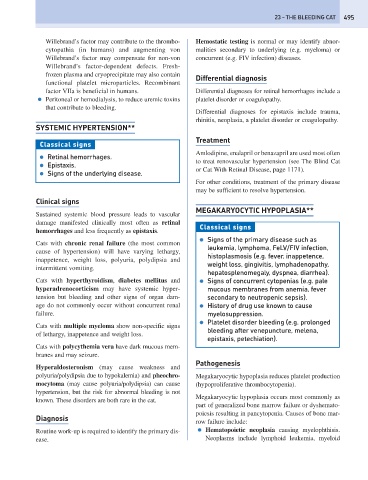Page 503 - Problem-Based Feline Medicine
P. 503
23 – THE BLEEDING CAT 495
Willebrand’s factor may contribute to the thrombo- Hemostatic testing is normal or may identify abnor-
cytopathia (in humans) and augmenting von malities secondary to underlying (e.g. myeloma) or
Willebrand’s factor may compensate for non-von concurrent (e.g. FIV infection) diseases.
Willebrand’s factor-dependent defects. Fresh-
frozen plasma and cryoprecipitate may also contain
Differential diagnosis
functional platelet microparticles. Recombinant
factor VIIa is beneficial in humans. Differential diagnoses for retinal hemorrhages include a
● Peritoneal or hemodialysis, to reduce uremic toxins platelet disorder or coagulopathy.
that contribute to bleeding.
Differential diagnoses for epistaxis include trauma,
rhinitis, neoplasia, a platelet disorder or coagulopathy.
SYSTEMIC HYPERTENSION**
Treatment
Classical signs
Amlodipine, enalapril or benazapril are used most often
● Retinal hemorrhages.
to treat renovascular hypertension (see The Blind Cat
● Epistaxis.
or Cat With Retinal Disease, page 1171).
● Signs of the underlying disease.
For other conditions, treatment of the primary disease
may be sufficient to resolve hypertension.
Clinical signs
MEGAKARYOCYTIC HYPOPLASIA**
Sustained systemic blood pressure leads to vascular
damage manifested clinically most often as retinal
Classical signs
hemorrhages and less frequently as epistaxis.
● Signs of the primary disease such as
Cats with chronic renal failure (the most common
leukemia, lymphoma, FeLV/FIV infection,
cause of hypertension) will have varying lethargy,
histoplasmosis (e.g. fever, inappetence,
inappetence, weight loss, polyuria, polydipsia and
weight loss, gingivitis, lymphadenopathy,
intermittent vomiting.
hepatosplenomegaly, dyspnea, diarrhea).
Cats with hyperthyroidism, diabetes mellitus and ● Signs of concurrent cytopenias (e.g. pale
hyperadrenocorticism may have systemic hyper- mucous membranes from anemia, fever
tension but bleeding and other signs of organ dam- secondary to neutropenic sepsis).
age do not commonly occur without concurrent renal ● History of drug use known to cause
failure. myelosuppression.
● Platelet disorder bleeding (e.g. prolonged
Cats with multiple myeloma show non-specific signs
bleeding after venepuncture, melena,
of lethargy, inappetence and weight loss.
epistaxis, petechiation).
Cats with polycythemia vera have dark mucous mem-
branes and may seizure.
Pathogenesis
Hyperaldosteronism (may cause weakness and
polyuria/polydipsia due to hypokalemia) and pheochro- Megakaryocytic hypoplasia reduces platelet production
mocytoma (may cause polyuria/polydipsia) can cause (hypoproliferative thrombocytopenia).
hypertension, but the risk for abnormal bleeding is not
Megakaryocytic hypoplasia occurs most commonly as
known. These disorders are both rare in the cat.
part of generalized bone marrow failure or dyshemato-
poiesis resulting in pancytopenia. Causes of bone mar-
Diagnosis
row failure include:
Routine work-up is required to identify the primary dis- ● Hematopoietic neoplasia causing myelophthisis.
ease. Neoplasms include lymphoid leukemia, myeloid

